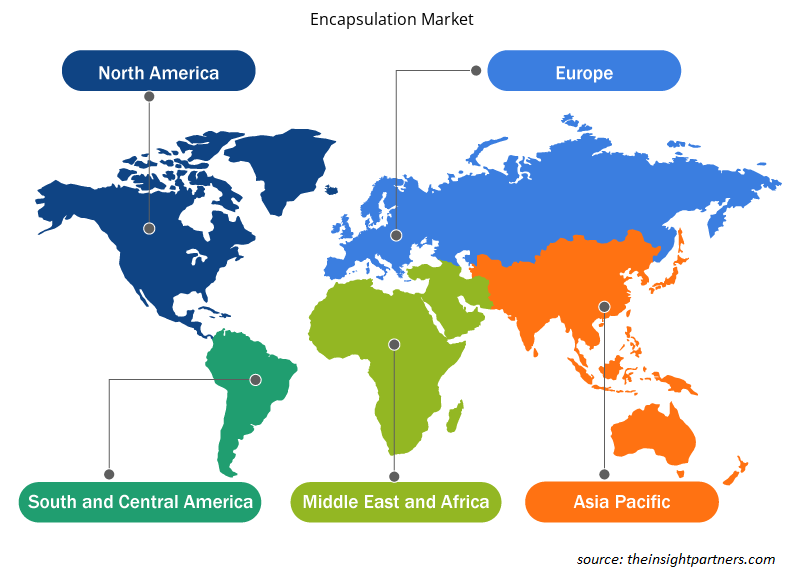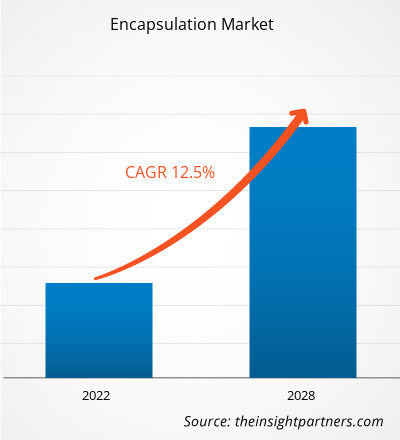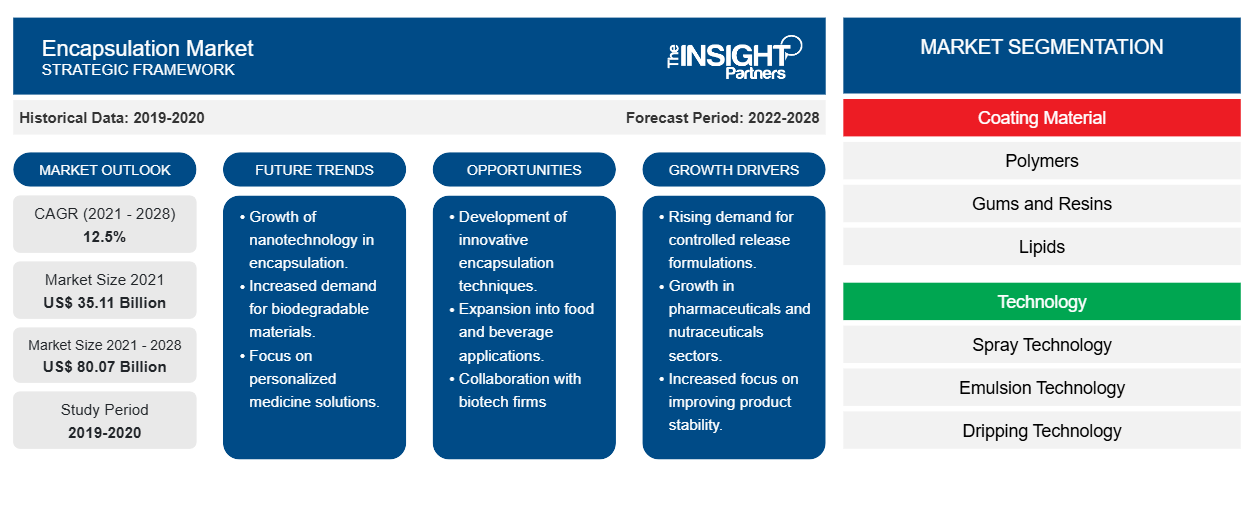Si prevede che il mercato dell'incapsulamento crescerà da 35.113,49 milioni di dollari nel 2021 a 80.071,65 milioni di dollari entro il 2028; si stima che crescerà a un CAGR del 12,5% dal 2021 al 2028.
La domanda di incapsulamento sta aumentando in modo significativo a causa della crescente domanda di aromi e colori incapsulati dal settore dei cibi pronti. Il mutevole ciclo di vita frenetico degli individui in tutto il mondo, insieme alla crescente popolazione urbana mondiale, determina la necessità di prodotti alimentari pronti. La domanda di prodotti farmaceutici incapsulati sta aumentando a causa del crescente carico di malattie, del miglioramento dei sistemi sanitari e dell'aumento dei redditi disponibili, che sta anche stimolando la crescita del mercato.
Si prevede che il mercato dell'incapsulamento nell'Asia Pacifica crescerà al CAGR più elevato durante il periodo di previsione. Molti paesi dell'Asia-Pacifico, come Cina e India, sono tra le popolazioni in più rapida crescita al mondo. L'industria alimentare si sta espandendo nella regione per la sua ampia gamma di applicazioni. L'esistenza di vari settori consolidati, come cibo e bevande, in Cina, India, Giappone e Corea del Sud ha aumentato la domanda di soluzioni di imballaggio nella regione. L'elevata domanda di integratori alimentari tra la popolazione più giovane sta guidando il mercato dell'incapsulamento. I principali componenti degli integratori alimentari, come vitamine ed enzimi, richiedono una consegna mirata. Alcuni fattori di tendenza come la consapevolezza della salute, la nutrizione e il benessere stanno guidando il comportamento dei consumatori per alimenti che supportano vite più lunghe e sane. La domanda di alimenti funzionali e integratori alimentari è in aumento tra la popolazione. Pertanto, con il crescente consumo di alimenti e bevande confezionati nella regione, si prevede che il mercato dell'incapsulamento nell'Asia Pacifica assisterà a una crescita significativa durante il periodo di previsione.
Personalizza questo report in base alle tue esigenze
Riceverai la personalizzazione gratuita di qualsiasi report, comprese parti di questo report, o analisi a livello nazionale, pacchetto dati Excel, oltre a usufruire di grandi offerte e sconti per start-up e università
-
Scopri le principali tendenze di mercato in questo rapporto.Questo campione GRATUITO includerà analisi di dati che spaziano dalle tendenze di mercato alle stime e alle previsioni.
Impatto della pandemia di COVID-19 sul mercato dell'incapsulamento
Con lo scoppio del COVID-19 in tutto il mondo, la maggior parte dei paesi ha dichiarato un'emergenza sanitaria e ha interrotto i movimenti non essenziali. La crisi ha avuto un impatto pesante sulla catena di fornitura dei beni. Nel mezzo della crisi, c'è un aumento della domanda di cibo e bevande sani da parte dei consumatori per rafforzare l'immunità. La pandemia di COVID-19 ha avuto un impatto negativo sul mercato globale dell'incapsulamento a causa della chiusura delle unità di produzione, dell'aumento dei prezzi delle materie prime, della carenza di manodopera, dell'interruzione delle catene di fornitura e dell'instabilità finanziaria. Inoltre, i governi di vari paesi stanno pianificando di sviluppare infrastrutture moderne e tecnologicamente avanzate per mitigare gli impatti economici della pandemia di COVID-19. Pertanto, aiuta a contribuire alla crescita del settore delle costruzioni, che aumenterebbe la domanda di incapsulamento nei prossimi anni. Si prevede che questa pandemia avrà un impatto basso sul mercato. Tuttavia, con l'allentamento delle norme, che sono state adottate per controllare la diffusione del virus, il mercato è ripreso con le precauzioni necessarie.
Approfondimenti di mercato
Crescente domanda di aromi e colori incapsulati nel settore dei cibi pronti
L'incapsulamento può fornire proprietà funzionali come il rilascio controllato in ambienti predeterminati. Gli aromi incapsulati sono ampiamente utilizzati nel settore del cibo pronto per il rilascio controllato di aromi e colori nei prodotti alimentari, tra cui bustine di tè, dolciumi, bevande istantanee e dessert. Il ciclo di vita frenetico e mutevole degli individui a livello globale e la crescente popolazione urbana in tutto il mondo determinano la necessità di prodotti alimentari pronti. Il settore del cibo pronto è costituito da prodotti alimentari progettati per ridurre i tempi di preparazione per l'utente finale. Il settore del cibo pronto ha assistito a un aumento sostanziale della domanda nell'ultimo decennio a livello globale e si prevede che aumenterà in modo significativo durante il periodo di previsione.
Approfondimenti sui materiali di rivestimento
In base al materiale di rivestimento, il mercato dell'incapsulamento è segmentato in polimeri, gomme e resine, lipidi, carboidrati e proteine. Il segmento dei carboidrati ha rappresentato la quota di mercato maggiore nel 2020, mentre si prevede che il segmento dei polimeri registrerà il CAGR più elevato nel mercato durante il periodo di previsione. I carboidrati sono i primi polimeri utilizzati per l'incapsulamento degli aromi grazie alle loro buone proprietà fisico-chimiche, alla buona solubilità in acqua, alla bassa viscosità e alle eccellenti proprietà barriera rispetto ai composti organici volatili. Il materiale di rivestimento per i carboidrati è costituito da amido, maltodestrine, chitosano, solidi di sciroppo di mais, destrano, amido modificato , fruttosio e ciclodestrine. L'incapsulamento dei polimeri è utilizzato nell'industria farmaceutica per farmaci somministrati per via orale e per mascherare il gusto e l'odore per migliorare la compliance del paziente e ridurre l'irritazione e la tossicità gastrointestinale.
Approfondimenti tecnologici
In base alla tecnologia, il mercato dell'incapsulamento è segmentato in tecnologia spray, tecnologia emulsione, tecnologia gocciolante e altre. Il segmento della tecnologia spray ha rappresentato la quota di mercato maggiore nel 2020. La tecnologia spray prevede la nebulizzazione di una soluzione acquosa in aria calda, che offre una maggiore efficienza. I vettori più consigliati per lo sviluppo di particelle mediante tecnologia spray nelle industrie alimentari sono alcoli, acidi grassi, triacilgliceroli e cere. La tecnologia emulsione intrappola materiale sensibile, come minerali e vitamine, nel vettore o nel materiale di rivestimento prima di essere aggiunto al cibo. Pertanto, consente ai nutrienti di essere abbastanza stabili e facilmente dispersi nel mezzo. Pertanto, la crescente domanda da parte del settore dei cibi pronti per aromi e alimenti incapsulati sta guidando la crescita del mercato globale dell'incapsulamento.
Approfondimenti sulle applicazioni
In base all'applicazione, il mercato dell'incapsulamento è segmentato in prodotti farmaceutici e nutraceutici, alimenti e bevande, prodotti per la cura della persona, prodotti agrochimici e altri. Si prevede che il mercato per il segmento farmaceutico e nutraceutico crescerà nei prossimi anni a causa del gran numero di aziende che utilizzano l'incapsulamento per mascherare il sapore o l'odore amaro dei farmaci e per fornire la loro somministrazione mirata e controllata. Anche il settore farmaceutico è fortemente influenzato dalle tecnologie di incapsulamento a causa dei vantaggi ottenuti dai produttori. L'incapsulamento per gli alimenti consente la ritenzione del sapore e rimuove il cattivo gusto. La crescente preferenza dei consumatori per alimenti sani e convenienti, la crescente domanda di alimenti confezionati e il cambiamento dello stile di vita, insieme alla preferenza per gli alimenti pronti, dovrebbero alimentare la crescita del mercato globale durante il periodo di previsione.
Alcuni attori che operano nel mercato dell'incapsulamento sono Encapsys, LLC; Lycored; Tastetech; Givadan; Balchem, INC; FrieslandCampina; DSM; Microtek Laboratories, INC; Legris Industries Group; e BASF SE. Le aziende chiave adottano strategie come fusioni e acquisizioni, ricerca e sviluppo per espandere la base clienti e ottenere una quota significativa nel mercato globale, il che consente loro anche di mantenere il loro marchio a livello globale.
Segnala i riflettori
- Tendenze industriali progressive nel mercato dell'incapsulamento per aiutare gli operatori a sviluppare strategie efficaci a lungo termine
- Strategie di crescita aziendale adottate dai mercati sviluppati e in via di sviluppo
- Analisi quantitativa del mercato dell'incapsulamento dal 2018 al 2028
- Stima della domanda globale di incapsulamento
- Analisi PEST per illustrare l'efficacia degli acquirenti e dei fornitori che operano nel settore
- Sviluppi recenti per comprendere lo scenario competitivo del mercato
- Tendenze e prospettive del mercato, nonché fattori che guidano e frenano la crescita del mercato dell'incapsulamento
- Assistenza nel processo decisionale evidenziando le strategie di mercato che sostengono l'interesse commerciale, portando alla crescita del mercato
- La dimensione del mercato dell'incapsulamento in vari nodi
- Panoramica dettagliata e segmentazione del mercato, nonché dinamiche del settore dell'incapsulamento
- Dimensioni del mercato dell'incapsulamento in varie regioni con promettenti opportunità di crescita
Approfondimenti regionali sul mercato dell'incapsulamento
Le tendenze regionali e i fattori che influenzano il mercato dell'incapsulamento durante il periodo di previsione sono stati ampiamente spiegati dagli analisti di Insight Partners. Questa sezione discute anche i segmenti e la geografia del mercato dell'incapsulamento in Nord America, Europa, Asia Pacifico, Medio Oriente e Africa e America meridionale e centrale.

- Ottieni i dati specifici regionali per il mercato dell'incapsulamento
Ambito del rapporto sul mercato dell'incapsulamento
| Attributo del report | Dettagli |
|---|---|
| Dimensioni del mercato nel 2021 | 35,11 miliardi di dollari USA |
| Dimensioni del mercato entro il 2028 | 80,07 miliardi di dollari USA |
| CAGR globale (2021 - 2028) | 12,5% |
| Dati storici | 2019-2020 |
| Periodo di previsione | 2022-2028 |
| Segmenti coperti |
Per materiale di rivestimento
|
| Regioni e Paesi coperti |
America del Nord
|
| Leader di mercato e profili aziendali chiave |
|
Densità degli attori del mercato: comprendere il suo impatto sulle dinamiche aziendali
Il mercato dell'Encapsulation Market sta crescendo rapidamente, spinto dalla crescente domanda degli utenti finali dovuta a fattori quali l'evoluzione delle preferenze dei consumatori, i progressi tecnologici e una maggiore consapevolezza dei vantaggi del prodotto. Con l'aumento della domanda, le aziende stanno ampliando le loro offerte, innovando per soddisfare le esigenze dei consumatori e capitalizzando sulle tendenze emergenti, il che alimenta ulteriormente la crescita del mercato.
La densità degli operatori di mercato si riferisce alla distribuzione di aziende o società che operano in un particolare mercato o settore. Indica quanti concorrenti (operatori di mercato) sono presenti in un dato spazio di mercato in relazione alle sue dimensioni o al valore di mercato totale.
Le principali aziende che operano nel mercato dell'incapsulamento sono:
- Encapsys, LLC
- Licorato
- Tecnologia del gusto
- Givadan
- Balchem, INC
Disclaimer : le aziende elencate sopra non sono classificate secondo un ordine particolare.

- Ottieni una panoramica dei principali attori del mercato dell'incapsulamento
Mercato dell'incapsulamento - per materiale di rivestimento
- Polimeri
- Gomme e Resine
- Lipidi
- Carboidrati
- Proteine
Mercato dell'incapsulamento – per tecnologia
- Tecnologia a spruzzo
- Tecnologia dell'emulsione
- Tecnologia di gocciolamento
- Altri
Mercato dell'incapsulamento - per applicazione
- Farmaceutica e nutraceutica
- Cibo e bevande
- Prodotti per la cura della persona
- Prodotti agrochimici
- Altri
Profili aziendali
- Azienda
- Licorato
- GustoTech
- Marchio Givaudan
- Società per azioni Balchem Inc.
- FrisiaCampina
- BASF SE
- Il DSM-5
- Microtek Laboratories, Inc.
- Gruppo Legris Industries
- Analisi storica (2 anni), anno base, previsione (7 anni) con CAGR
- Analisi PEST e SWOT
- Valore/volume delle dimensioni del mercato - Globale, Regionale, Nazionale
- Industria e panorama competitivo
- Set di dati Excel
Report recenti
Testimonianze
Motivo dell'acquisto
- Processo decisionale informato
- Comprensione delle dinamiche di mercato
- Analisi competitiva
- Analisi dei clienti
- Previsioni di mercato
- Mitigazione del rischio
- Pianificazione strategica
- Giustificazione degli investimenti
- Identificazione dei mercati emergenti
- Miglioramento delle strategie di marketing
- Aumento dell'efficienza operativa
- Allineamento alle tendenze normative























 Ottieni un campione gratuito per - Mercato dell'incapsulamento
Ottieni un campione gratuito per - Mercato dell'incapsulamento